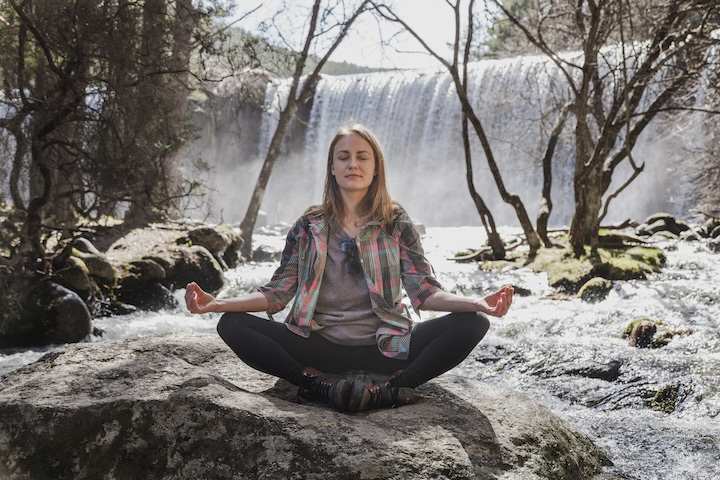Grounding Meditation: Powerful Practice for Stress Relief & Calm (Expert Guide)

Feeling scattered or overwhelmed? Grounding meditation might be the perfect tool to help you achieve calm and relaxation. Grounding meditation is a mindfulness practice that anchors you to the present moment, helping to reduce stress and improve focus.
It involves techniques like deep breathing and visualization to connect you deeply with the earth and the here and now. Before diving into grounding meditation, it’s essential to prepare yourself adequately.
Creating a quiet space and setting a clear intention can immensely enhance your practice. Guided grounding meditation sessions allow you to easily follow along and develop your skills in staying present and centered.
Don’t be discouraged even if you face obstacles in maintaining a consistent practice. Incorporating grounding techniques into your daily routine can gradually build resilience and a stronger presence of mind. Explore the benefits, methods, and tips to overcome challenges in your journey with grounding meditation.
Key Takeaways
- Grounding meditation reduces stress and improves focus.
- Set a clear intention and create a quiet space before starting.
- Guided sessions and consistent practice help you stay present.
What Is Grounding Meditation
Grounding meditation helps you connect your mind to your body and the earth. This practice can enhance balance, promote harmony, and stabilize your energy.
Defining Grounding Meditation
Grounding meditation is a practice that anchors you to the present moment. It involves specific techniques that focus on reconnecting your body and mind to the earth. For example, you might visualize roots extending from your body into the ground, stabilizing yourself.
Focusing on these connections can calm your mind and restore a sense of balance. This meditation often involves deep breathing and mindful awareness. The overall goal is to create a sense of stability and inner peace.
Benefits of Being Grounded
Grounding meditation offers multiple benefits for your overall well-being. It can help reduce anxiety and stress by calming your mind and body. Feeling grounded makes you less likely to be overwhelmed by outside pressures.
Physically, grounding can enhance your energy levels and promote better health. It can also improve focus and clarity, helping you make better decisions. By grounding yourself regularly, you can achieve a state of balanced harmony.
Science Behind Grounding Meditation
The science behind grounding meditation supports its effectiveness in stabilizing your energy and promoting well-being. Research suggests that this practice can reduce cortisol levels, which helps manage stress.
Grounding techniques also stimulate the parasympathetic nervous system, encouraging relaxation. Studies have shown that regular grounding can improve heart rate variability, a marker of cardiovascular health.
Additionally, grounding can enhance mitochondrial function in cells, improving overall energy levels. These scientific insights reinforce the benefits of grounding meditation for both mind and body.
Preparation for Grounding Meditation

Preparatory steps are essential for an effective grounding meditation. Setting up a conducive environment and ensuring physical comfort are key factors to ensure a focused and enriching experience.
Creating a Conducive Environment
Select a quiet place where you won’t be interrupted. Like a garden or park, nature settings offer a serene backdrop, incorporating natural sounds and fresh air, enhancing the grounding process. If indoors, choose a well-ventilated space with minimal clutter.
Dim lighting can help create a calming atmosphere. You might use soft rugs or cushions for added comfort.
Ensure the space’s temperature is comfortable. A too-cold or too-hot environment can distract from meditation. Scents like essential oils can enhance relaxation but avoid overpowering fragrances.
Physical Posture and Comfort
Your body position greatly affects your meditation. Sit on a chair with your feet flat on the ground or cross-legged on a cushion. Ensure your back is straight but not rigid, promoting alertness without strain.
Comfort is crucial. Wear loose, comfortable clothing that doesn’t restrict movement. Consider using a cushion or bolster to support your position and alleviate pressure points.
Direct contact with the earth often benefits grounding. If possible, sit directly on the ground or grass outdoors. This physical connection can deepen your sense of being grounded.
Stay relaxed and focused, allowing your body to settle into a comfortable, sustainable position.
Grounding Techniques and Practices
Grounding meditation involves various techniques to connect you with the earth’s energy, creating a sense of presence and stability. Key methods include breathwork, visualization, rooting, and the use of natural elements.
Breath and Breathing Techniques
Breathwork is crucial for grounding. Deep, slow breathing helps focus your mind and body. 4-7-8 breathing is effective: inhale for 4 counts, hold for 7, exhale for 8.
Box breathing follows a pattern: inhale for 4 counts, hold for 4, exhale for 4, and hold again for 4.
Diaphragmatic breathing involves breathing deeply into your diaphragm rather than shallowly into your chest.
Regular practice of these techniques can enhance emotional balance and mental clarity.
Visualization Techniques
Visualization can anchor you to the present moment. Imagine roots growing from your feet into the earth. This mental imagery strengthens your connection to the ground.
Another technique is the golden light method. Visualize a warm light flowing from the top of your head through your body, exiting through your feet into the earth.
These visualizations support mental focus and energy alignment.
Rooting Techniques
Rooting practices involve physical and mental exercises to establish a strong connection to the earth. Stand with feet shoulder-width apart, and imagine roots growing from your feet deep into the ground.
Focus your awareness on the sensation of being anchored and stable.
You can also try tree pose in yoga, balancing on one foot while pressing the other foot against your standing leg, enhancing your sense of grounding and balance.
Using Nature as a Ground
Nature itself can be a powerful grounding tool. Walk barefoot on grass, sand, or soil to directly connect with the earth’s energy.
Gardening or simply sitting by a tree can also enhance this connection.
Earthing or grounding mats are alternatives if outdoor access is limited. Spending time in nature increases your awareness and presence, fostering a deep sense of grounding and well-being.
Guided Grounding Meditation Sessions
Guided grounding meditation sessions can provide you with structured guidance and the expertise of experienced teachers or therapists. Selecting the right guidance and understanding the benefits are essential for a rewarding meditation experience.
Finding and Choosing Guidance
Choosing the right guidance is crucial.
Look for a qualified meditation teacher or therapist with experience in grounding techniques. Verify their credentials and expertise. Recommendations from friends or online reviews can help you find reputable instructors.
Consider different formats: in-person sessions, online classes, or pre-recorded guides. Each has its own advantages. Online sessions offer flexibility in location, while in-person classes may provide a more immersive experience. Pre-recorded guides allow you to practice at your own pace.
Evaluate your needs. Whether you prefer one-on-one guidance or group sessions, ensure that the chosen method aligns with your comfort and goals.
Benefits of Guided Meditation
The benefits of guided grounding meditation are numerous.
A guided session helps you stay focused and present. The instructor’s voice and cues direct your attention, reducing distractions.
Guided meditation can promote deep relaxation. Expert guidance helps you meditate more easily, enhancing the calming effects on your mind and body.
It can be a source of personal growth. Working with a trained practitioner provides personalized insights and support, enabling deeper self-awareness and emotional balance.
Guided grounding meditation sessions can also improve consistency in practice. Scheduled sessions create a regular routine, making integrating meditation into your daily life easier.
Obstacles in Grounding Meditation

Grounding meditation can present several obstacles, including common issues that meditators face and signs that indicate when professional help may be necessary.
Common Challenges and How to Overcome Them
A frequent challenge in grounding meditation is the difficulty of maintaining focus. You might find your mind wandering repeatedly. To address this, try using tools like a guided meditation app or focus on breathing exercises to keep your attention anchored.
Another obstacle is physical discomfort. Long periods of sitting can lead to aches and pains. To alleviate discomfort, consider using cushions or chairs to support your body and practicing stretches before meditating.
Emotional distress can also arise. Feelings of anxiety or sadness may surface. When this happens, it is important to remain patient with yourself. Try shorter meditation sessions initially and gradually increase the duration as you become more comfortable.
Lastly, discipline and consistency can be hard to maintain. Setting a regular schedule and creating a dedicated meditation space can help build a routine that becomes easier to stick with over time.
When to Seek Professional Help
You should consider seeking professional help if you experience intense emotional responses during meditation that are difficult to manage. This can include overwhelming feelings of anxiety, depression, or trauma that interfere with your daily life.
Another indicator is persistent physical pain that worsens with meditation. Ongoing discomfort that does not improve with adjustments in posture may require consultation with a healthcare provider to rule out underlying conditions.
Working with a professional can provide structure and guidance if you cannot establish or maintain a meditative practice despite consistent effort. Look for trained meditation instructors or mental health professionals who can offer personalized support.
Remember, seeking help is a proactive step to ensure your meditation practice is beneficial and sustainable.
Frequently Asked Questions
Grounding meditation offers various benefits, including improved sleep, reduced anxiety, and efficient techniques that can be performed quickly. Below, you will find answers to common questions about grounding meditation techniques and their applications.
How do grounding meditation techniques improve sleep quality?
Grounding meditation can help calm your mind and body, making it easier to fall asleep. By focusing on the present moment and releasing stress, you can achieve a more restful and uninterrupted sleep.
Can grounding meditation reduce anxiety, and if so, how?
Yes, grounding meditation can reduce anxiety by helping you focus on the present and disconnect from anxious thoughts. Techniques such as deep breathing and sensory awareness promote relaxation and a sense of calm.
What is the 5-4-3-2-1 grounding exercise, and how is it performed?
The 5-4-3-2-1 exercise involves identifying five things you can see, four things you can touch, three things you can hear, two things you can smell, and one thing you can taste. This technique shifts your focus to the present moment.
Are there quick grounding meditation practices that can be done in under 5 minutes?
Simple practices like deep breathing, tactile awareness, and brief body scans can be performed in under five minutes. These quick techniques are effective for immediate stress relief and grounding.
How does grounding meditation differ from other forms of mindfulness practices?
Grounding meditation specifically focuses on connecting with the present moment through sensory awareness and physical sensations. Other mindfulness practices may emphasize broader aspects of consciousness or spiritual elements.
What are some effective scripts or guidelines for conducting grounding meditation?
Effective scripts for grounding meditation often include step-by-step instructions on focusing attention on the breath, sensory experiences, and physical presence. Using calming and descriptive language can enhance the practice’s effectiveness.







